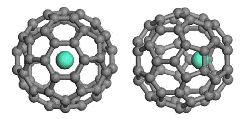Chemistry, Department of: Faculty Series

Xiao Cheng Zeng Publications
Document Type
Article
Date of this Version
5-11-2005
Abstract
Cooperative effects in two-dimensional cyclic networks containing intermolecular three-centered hydrogen bonding interactions of the type H1&#;A&#;H2 are investigated by means of ab intio molecular orbital and density functional theory calculations. Ring-like clusters consisting of three and up to nine monomers of the cis–cis isomer of carbonic acid H2CO3 are used as basic models, where each unit acts simultaneously as a double hydrogen-bond donor and double hydrogen-bond acceptor. Cooperative effects based on binding energies are evident for (H2CO3)n, where n goes from 2 to 9. Thus, the ZPVE-corrected dissociation energy per bifurcated hydrogen bond increases from 11.52 kcal/mol in the dimer to 20.42 kcal/mol in the nonamer, i.e., a 77% cooperative enhancement. Cooperative effects are also manifested in such indicators as geometries, and vibrational frequencies and intensities. The natural bond orbital analysis method is used to rationalize the results in terms of the substantial charge delocalization taking place in the cyclic clusters. Cooperativity seems close to reaching an asymptotic limit in the largest ring considered, n=9.


Comments
Published by American Institute of Physics. J. Chem. Physics 122, 184325 (2005). ©2005 American Institute of Physics. Permission to use. http://jcp.aip.org/.